|
|
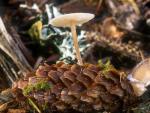
|
Baeospora myosura
|
Pileus
Cap 1.0-2.5 cm broad, convex, expanding to nearly plane, the disc occasionally slightly raised; margin at first decurved, then plane, not striate, or if so, obscurely; surface dry, glabrous at the disc, sometimes becoming fibrillose toward the margin; color: tan-brown at the disc, shading to buff-brown at the margin; context thin, less than 1 mm thick, colored like the cap; odor and taste mild. |
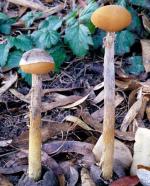
|
Battarraea phalloides
|
Sporocarp
Fruiting body 4-7 cm broad, 2-3 cm thick, compressed-globose, white to cream, partially buried in the substrate; exoperidium, ruptured by spore sac and elongating stalk; spore sac 2.5-4.5 cm broad, 2-3 cm thick, convex, covered by a white membranous endoperidium, the latter splitting horizontally along the margin, exposing a sticky, brown spore mass; stalk 15-35 cm tall, 0.5-1.5 cm thick, equal to tapered at the base, dry, with fibrous, rusty-brown scales; a membranous volva at the base shrivels in age. |
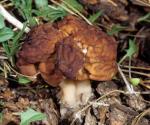
|
Beefsteak Morel: Gyromitra esculenta
|
Pileus
Cap 5-9 cm tall, 5-11 cm broad, semi-globose, brain-like, inconspicuously lobed; fertile surface convoluted to wrinkled, lobes separated by deep furrows; color: tan-brown, ochraceous-brown, deep reddish-brown; sterile undersurface of cap cream to buff-colored; margin attached to stipe at several points; context thin, brittle; odor and taste not distinctive. |
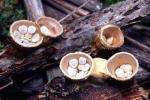
|
Bird's Nest Fungus: Crucibulum laeve
|
Sporocarp
Fruiting body cup-shaped, sessile, tough, persistent, 3-7 mm high, 3-6 mm wide, globose, becoming cylindrical, narrowed at the base, flaring at the mouth, the latter covered with an ochraceous, velvety, evanescent lid (epiphragm); outer surface roughened to finely wrinkled, buff-brown, inner surface smooth, pale grey to light-brown; peridioles (eggs) 1-2 mm broad, flattened, white to pallid, connected to the cup by a thin cord (funiculus). |
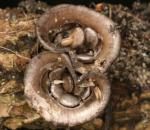
|
Bird's Nest Fungus:Cyathus olla
|
Sporocarp
Fruiting body at maturity 10-15 mm in height, up to 13 mm broad, the base narrow, tapering upward, flaring at the mouth; margin frequently wavy, occasionally slightly reflexed; when young the mouth covered with a cream to buff-brown membranous lid (epiphragm); peridium tough, pliant, the outer surface with appressed, fine, brownish-grey hairs, inner surface smooth, shiny, grey, not striate, but sometimes with faint concentric bands; peridioles, disc-shaped silvery-grey, enclosed in a translucent to whitish thin membrane (use hand-lense) and attached to the inner cup surface or to each other via a short, white cord (funiculus). |
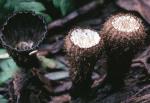
|
Bird's Nest Fungus:Cyathus striatus
|
Sporocarp
Fruiting body cup-shaped, the base narrow, flaring upward, 0.5-1.0 cm tall, 0.4-0.8 cm broad, tough, persistent, the mouth covered with an evanescent, whitish, pubescent membrane; outer surface faintly grooved, shaggy with grey-brown to dark-brown hairs, in age matted to roughened; inner surface shiny-smooth, conspicuously grooved or ribbed; peridioles (eggs) light-grey to dark-grey, smooth, flattened, attached to the cup by a short, elastic cord (funiculus). |
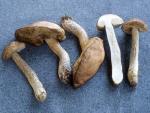
|
Birch Bolete: Leccinum scabrum
|
Common Name: birch bolete
Pileus
Cap 5.0-14.0 cm broad, convex, broadly convex in age with a decurved margin; surface when young, dingy-tan, dull, matted-tomentose, subviscid, occasionally areolate; at maturity sometimes weathering glabrous, becoming viscid, medium-brown to dull olive-brown; context soft, up to 1.5 cm thick, cream-colored, unchanging or occasionally faintly pink or blue where cut or injured; odor and taste mild. |
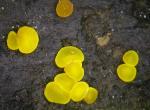
|
Bisporella sulfurina
|
Sporocarp
Apothecia 0.5-1.0 mm broad, sessile, at first urn-like, centrally concave, becoming cushion-shaped to discoid; hymenium glabrous, bright yellow to citrine, slightly translucent; exterior colored like the disc or paler; margin more or less even, lacking hairs; context soft, fleshy, yellowish; odor and taste not investigated. |
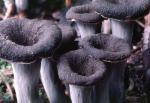
|
Black Chanterelle: Craterellus cornucopioides
|
Sporocarp
Fruiting body 2-7 cm broad, 3-9 cm tall, funnel-shaped, margin undulate, sometimes irregularly torn; surface dry with fine scales, dark grey to blackish when moist, fading to lighter tones when dry; flesh thin, leathery; spore bearing surface smooth to slightly wrinkled, pale grey. |
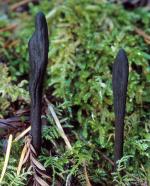
|
Black Earth Tongue: Geoglossum fallax
|
Sporocarp
Fruiting body club-shaped, 2-7 cm tall, fertile "head," 2-6 mm thick, flattened, sometimes grooved, brown to dark-brown, rarely black, minutely hairy from projecting asci (not setae); stipe round, 1-2 mm thick, solid at the base, often hollow near the apex, colored like the "head," roughened or with scattered small scales. |
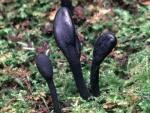
|
Black Earth Tongue:Trichoglossum hirsutum
|
Sporocarp
Fruiting body clavate, 1.5 -7.0 cm tall, the fertile "head" oblong to spade-shaped, flattened, often grooved, 0.5-1.5 cm long, 2-5 mm wide, black, velvety from projecting hairs or spines; stipe round, 1-2.5 mm thick, equal, black, conspicuously pubescent. |
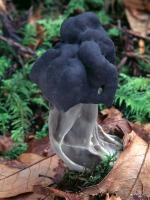
|
Black Elfin Saddle: Helvella lacunosa
|
Pileus
Head of the fruit body 4-7 cm high, 3-5 cm broad, convoluted and irregularly lobed, sometimes saddle-shaped; margin attached to stipe at several points; flesh thin, brittle; hymenium grey-black to black, sterile inside tissue grey to dark grey. |
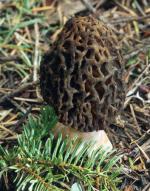
|
Black Morel: Morchella elata
|
Pileus
Cap 2.0-8.0 cm tall, 2.0-6.0 cm broad, narrowly to broadly conic, occasionally more rounded, i.e. obtuse-conic to ovoid-conic; surface of parallel to meandering ridges and cross-ribs, pubescent when young in some forms; color at first greyish to ochre-brown, occasionally pinkish to blackish overall; with age the ridges dark-grey to blackish-brown, the pits lighter, i.e. ochre to grey-brown; margin when young, overlapping the stipe attachment, less so in age; context whitish, thin, firm, brittle, interior hollow; odor earthy to fungal; taste not investigated. |
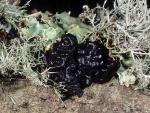
|
Black Witch's Butter: Exidia glandulosa
|
Sporocarp
Fruiting body 1-2 cm broad, irregularly convoluted to brain-like, often aggregated into masses up to 10-20 cm long and 3-5 cm broad; upper surface fertile, smooth to warted, olive-black to black; flesh gelatinous, soft, thin, in dry weather forming a black crust on the substrate; odor and taste mild. |
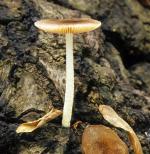
|
Bolbitius aleuriatus
|
Pileus
Cap 1.5-3.0 cm broad, convex to campanulate, expanding to nearly plane, sometimes centrally depressed or with a low umbo; margin striate-plicate, decurved when young, plane to slightly raised in age; surface viscid when moist, disc glabrous to reticulate, greyish-brown to greyish-purple, shading to a light-grey margin; context white, unchanging, soft, thin, up to 2 mm thick; odor and taste not distinctive. |
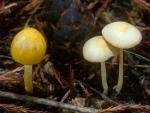
|
Bolbitius vitellinus
|
Pileus
Cap 2-6 cm broad, conic, becoming broadly convex with age; surface smooth, viscid, yellow to bright yellow when fresh, fading to whitish or greyish; margin striate; flesh thin, very fragile. |
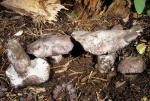
|
Boletopsis subsquamosa: Boletopsis leucomelaena
|
Pileus
Cap 5.0-13.0 cm broad, convex, broadly so in age, often irregular with depressed and raised areas; margin incurved, then decurved, wavy; surface dry, glabrous to patchy appressed-fibrillose, pallid when unexposed, soon greyish to blackish-brown, sometimes with purplish tints, darker where handled; context white, firm, up to 3.0 cm thick at the disc, unchanging to slowly pale-grey; odor mild to fragrant; taste frequently bitter. |
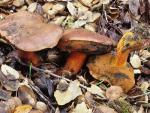
|
Boletus amygdalinus
|
Pileus
Cap 4-10 cm broad, convex, broadly convex at maturity, margin often lobed or wavy, incurved when young; surface dry, at first chamois-like, then more or less glabrous in age, reddish-brown fading slightly at maturity; flesh thick, reddish beneath the cuticle, otherwise yellow, turning blue immediately when cut; odor and taste mild. |
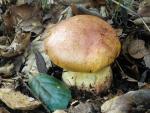
|
Boletus appendiculatus
|
Pileus
Cap 7-14 cm broad, convex, expanding to nearly plane, the disc sometimes slightly depressed; margin at first incurved, then decurved, occasionally wavy; surface dry to subviscid depending on conditions, glabrous to minutely tomentose; color variable: cream-yellow, buff-brown to yellow-brown, often flushed with rusty to reddish-brown tints in age, darkening where handled; context 1.5-3.0 cm thick, firm, cream to pale-yellow, unchanging or bluing erratically; odor and taste mild. |
.jpg)
|
Boletus chrysenteron
|
Pileus
Cap 4-9 cm broad, convex, becoming nearly plane in age; surface dry, tomentose, dark brown to olive brown, soon areolate, the exposed context pallid at the disc, pinkish near the margin; flesh white, thick, sometimes blueing when bruised; odor mild, taste acidic. |
.jpg)
|
Boletus citriniporus
|
Pileus
Cap 4-8 cm broad, convex, broadly so in age; margin at first incurved, then decurved; surface matted tomentose to appressed squamulose, sometimes faintly cracked in older specimens; color dark-brown; context white, firm, moderately thick, unchanging when injured; odor and taste mild. |
.jpg)
|
Boletus dryophilus
|
Pileus
Cap convex 4-12 cm broad, expanding to plano-convex; surface dry, somewhat irregular with scattered bumps and depressions, matted tomentose, frequently partially areolate at maturity; color variable: reddish-brown, maroon, pinkish between cracks in the cuticle, in age often lighter from overlying greyish hairs; context moderately thick, pale yellow, bluing where cut or injured, especially at the junction of the stipe and cap; odor and taste mild. |
.jpg)
|
Boletus eastwoodiae
|
Synonym: Suillellus eastwoodiae Murrill
Misapplied name: Boletus satanas Lenz |
.jpg)
|
Boletus flaviporus
|
Pileus
Cap 6-11 cm broad, convex, the margin incurved, becoming broadly convex in age, the margin then wavy; surface viscid, innately fibrillose to reticulate, cinnamon-brown to reddish-brown, shading to a slightly lighter margin, darker overall in age; flesh white, moderately thick, not bruising blue; odor mild; taste mild to sour. |
.jpg)
|
Boletus frustosus
|
|
Synonym: Boletus calopus var. frustosus (Snell & Dick) Miller & Watling |
.jpg)
|
Boletus haematinus
|
Habitat
Scattered to gregarious under red fir (Abies magnifica) in the Sierra Nevada Mountains; fruiting in the fall, rarely in the spring. |
.jpg)
|
Boletus mirabilis
|
|
Pileus
Cap 7-14 cm broad, convex, expanding to plano-convex; margin decurved when young, level in age, extending beyond the tube layer; surface maroon-brown, to dark reddish-brown, coarsely matted-tomentose to squamulose in age, sometimes with pinkish blotches from the underlying ground color; context 1-2 cm thick, soft, pallid to pale pink, occasionally yellowish, often vinaceous just below the cuticle, unchanging where exposed; odor mild; taste slightly lemon-like. |
.jpg)
|
Boletus orovillus
|
Pileus
Cap 8-15 cm broad, convex, becoming plano-convex; margin at first incurved, then decurved, often overlapping the tubes, even to wavy, sometimes slightly upturned at maturity; surface sticky when moist, otherwise dry, glabrous or with faint appressed fibrils, occasionally areolate; color when fresh, bright sulphur-yellow, fading to dull yellow, the disc often tinged pale brown; cuticle peelable from the underlying context, the latter up to 2 cm thick; context relatively soft, yellowish, young material quickly bluing when cut or injured, in age bluing erratically or not at all, sometimes vinaceous-pink above the tube layer; odor and taste mild. |
.jpg)
|
Boletus pinophilus: Boletus rex-veris
|
Common Name: Spring King
Misapplied names: Boletus pinophilus Pilat & Dermak; Boletus edulis Fries; Boletus edulis var. pinicola Vittadini; Boletus pinicola (Vittidini) Venturi |
.jpg)
|
Boletus piperatoides: Chalciporus piperatoides
|
Pileus
Cap 2.5-6.0 cm broad, convex, broadly convex in age; margin decurved, becoming nearly plane at maturity; surface sticky when moist, otherwise dry, matted-tomentose, chamois-like, areolate in dry weather; color variable: ochre, rusty-brown, tan to cinnamon-brown, often tinged vinaceous; context up to 1.5 cm thick, pale tawny-buff, soft, bluing erratically; odor: fruity-aromatic; taste: peppery. |
.jpg)
|
Boletus pulcherrimus
|
Pileus
Cap 9-17 cm broad, convex, expanding to broadly convex; margin incurved when young, then decurved, often wavy, overlapping the pore surface; surface dry, uneven or pitted, matted-tomentose, at maturity occasionally appressed fibrillose-squamulose, in dry weather patchy-areolate; color: dull-brown to cream-brown, the pigments often mottled, frequently tinged reddish towards the margin; context cream-yellow, 3.0-4.0 cm thick at maturity, soft, bluing when cut, sometimes erratically, larval tunnels vinaceous; odor not distinctive; taste mild. |
.jpg)
|
Boletus regineus
|
Pileus
Cap 7.0-14.0 (17) cm broad, convex, expanding to plano-convex; margin incurved, later decurved to nearly plane, not overlapping the tube layer; surface moist, more or less glabrous when young, becoming irregularly pitted or wrinkled; color at first unevenly buff-brown to pale chestnut-brown, overlain initially with a whitish bloom, in age becoming medium-brown to dark-brown, subviscid when moist; context up to 2.0 cm thick white, unchanging, firm in youth, soft at maturity, tinged pinkish-vinaceous below the cuticle, sometimes yellowish above the tube layer; odor and taste mild. |
.jpg)
|
Boletus regius
|
Pileus
Cap 8.0-15.0 (20) cm broad, strongly convex, expanding to plano-convex; margin incurved, becoming decurved to plane in age; surface subviscid when moist, otherwise dry, with irregular bumps, pits and depresssion, at first ornamented with patches of appressed fibrils, these often wearing away in age, then appearing glabrous; color rose-red to pale-pink, quickly fading with exposure to light to various combinations of buff, tan, or dull pale-yellow; context lemon-yellow, firm, up to 2.5 cm thick, slowly bluing when cut or injured, bluing reaction strongest just above the tube layer; odor mild; taste mild, pleasant. |
.jpg)
|
Boletus smithii
|
Pileus
Cap 7-15 cm broad, convex, broadly convex in age; margin at first incurved, eventually decurved, occasionally wavy; surface moist, not viscid, hygrophanous, uneven, with shallow depressions and pits, matted-tomentose to fibrillose, sometimes patchy-areolate or weathering to glabrous; color: wine-red over a background of cream-yellow, tan-buff, grey-brown, the margin usually paler; context white to cream-yellow, soft, 1.5-3.0 cm thick, bluing faintly near the tube layer, worm holes reddish; odor and taste mild. |
.jpg)
|
Boletus truncatus
|
Pileus
Cap 5-10 cm broad, convex, broadly convex to nearly plane in age; surface dry, tomentose, brown to olive-brown, usually cracking early in development revealing underlying yellowish to pinkish tissue, the latter more prevalent toward the margin; flesh thick, light yellow, blueing irregularly when injured; odor mild, taste acidic. |
.jpg)
|
Boletus zelleri
|
Pileus
Cap 4-11 cm broad, convex, nearly plane at maturity; brown to blackish-brown, velvety, smooth to uneven, with a whitish bloom when young, occasionally aereolate in age; flesh pallid to yellowish, sometimes bruising blue. |
.jpg)
|
Bovista californica
|
Sporocarp
Fruiting body small, 5-15 (20) mm broad, subglobose to compressed globose, sessile, attached to the substrate by a tuft of soil-encrusting mycelium; exoperidium thin, white, flocculose, fragmenting in age (except apically), leaving tiny pallid to buff-colored scales over a dull-brown, papery endoperidium; spores released via a small, raised apical pore; gleba brown in age, elastic; subgleba and sterile base absent; odor and taste not determined. |
.jpg)
|
Bovista pila
|
Sporocarp
Fruiting body 4.0-7.0 cm broad, globose to slightly compressed, lacking a sterile base, attached to the substrate via a white mycelial cord; peridium thin, <1.0 mm thick; exoperidium white, glabrous to matted-tomentose, becoming dingy-tan, occasionally squamulose to areolate, eventually dark-brown to mahogany-brown; exoperidium persistent, often present at maturity, gradually peeling away, absent only in weathered material; endoperidum metallic-grey, sometimes patchy bronze-brown to purple-brown where overlain with remnants of exoperidium; gleba white, turning olivaceous, then dark-brown to slightly purplish at maturity, texture firm; spores released via apical cracks and tears; sterile base and subgleba absent; odor and taste mild. |
.jpg)
|
Bovista plumbea
|
Sporocarp
Fruiting body 1.5-3.5 cm broad, globose to slightly compressed, attached to the substrate by a tuft of mycelium; exoperidium white, glabrous, becoming buff to pale-tan and minutely tomentose, sometimes areolate; exoperidium flaking away, or peeling off in sheets, the latter typical of maturation in hot, dry conditions; endoperidium membranous, lead-grey, with or without adhering fragments of exoperidium; spores released via a small apical pore; gleba white, turning dingy yellowish, olive-brown, finally dark-brown, firm-textured; subgleba and sterile base absent. |
.jpg)
|
Brown Witch's Butter: Tremella foliacea
|
Sporocarp
Fruiting body 5-15 cm broad, globose to cushion-shaped, a mass of ruffled, leaf-like blades fused to a common base; surface viscid in wet weather, otherwise moist, individual blades variously wrinkled to folded, upper and lower surfaces fertile; color: dull brownish-vinaceous to cinnamon-brown, darkening in age; context thin, somewhat translucent, rubbery; odor and taste mild. |
.jpg)
|
Bulgaria inquinans
|
Common Name: black jelly drops
Synonym: Phaeobulgaria inquinans (Persoon) Nannfeldt |
.jpg)
|
Byssonectria terrestris
|
Habitat
Gregarious to crowded on soil and duff where animals have urinated; montane; spring. |
|
|